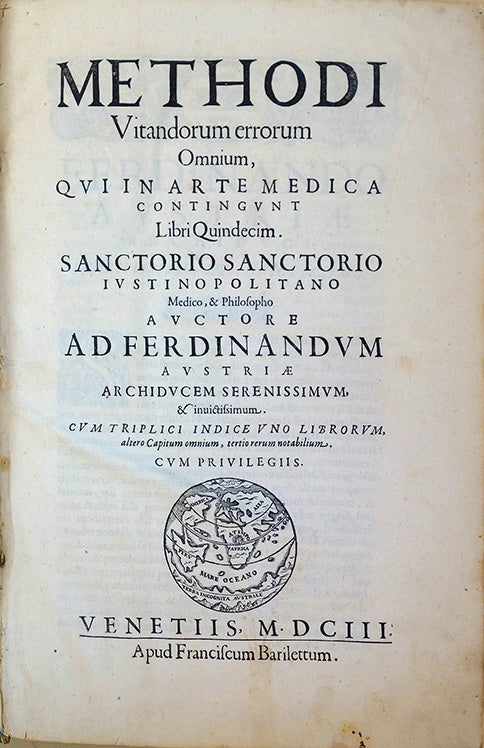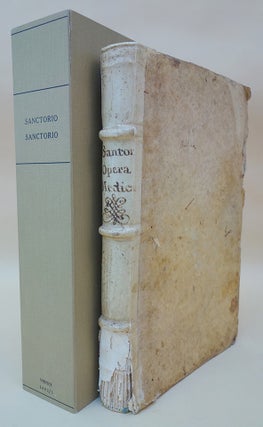Methodum vitandorum errorum omnium, qui in arte medica contingunt libri quidecim.
Publisher Information: Venice: Francesco Bariletti, 1603.
Santorio, Santorio (1561-1636). Methodi vitandorum errorum omnium, qui in arte medica continunt libri quindecim. Folio. [6], 230, [16]ff. Venice: Francisco Bariletti, 1603. Vellum ca. 1603, lower quarter of vellum spine lacking; preserved in a cloth folding box. Mostly minor marginal worming (heavier at the end of the book), light marginal staining. Very good.
First Edition. Santorio’s extremely rare first published work, in which he introduced the radical idea that the properties of the body depended not only on the traditional imprecise Galenic interpretation of the balance of humors, but also on qualities that could be measured quantitatively with instruments. In this work Santorio presented his first discussion of his pulse-clock (‘pulsilogium’), the first instrument for measuring the pulse, and his scale. A few sources, including Hirsch and the Dictionary of Scientific Biography, cite a 1602 edition, but we have not been able to find any record of this edition in OCLC, the British Museum online catalogue, or the Karlsruhe database.
This is one of the rarest medical books of the seventeenth century. To the best of our knowledge this is only the second copy that has appeared on the market during the past 40 years.
Throughout most of the seventeenth and eighteenth centuries, Santorio’s name was linked with that of Harvey as the greatest figure in physiology and experimental medicine because of his introduction of precision instruments for quantitative studies. He was also the founder of metabolic research. Using himself as a subject, Santorio conducted a long series of experiments with the scale and pulse-clock first mentioned here, as well as with a thermometer and other measuring instruments. He used these instruments to measure such metabolic phenomena as pulse rate, respiration, body temperature and the daily variations in the weight of his body relative to ingestion and excretion. Santorio’s work introduced quantitative experimentation into biological science and opened the way to mathematical and experimental analysis of physiological phenomena. Garrison-Morton.com 572.1. Wellcome I, 5757. Krivatsy 10250. Gedeon, Science and Technology in Medicine pp. 54-55.
Book Id: 45021Price: $12,500.00


